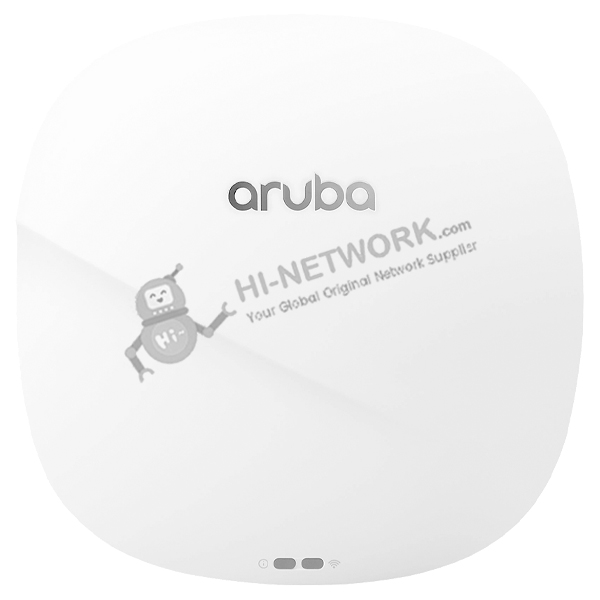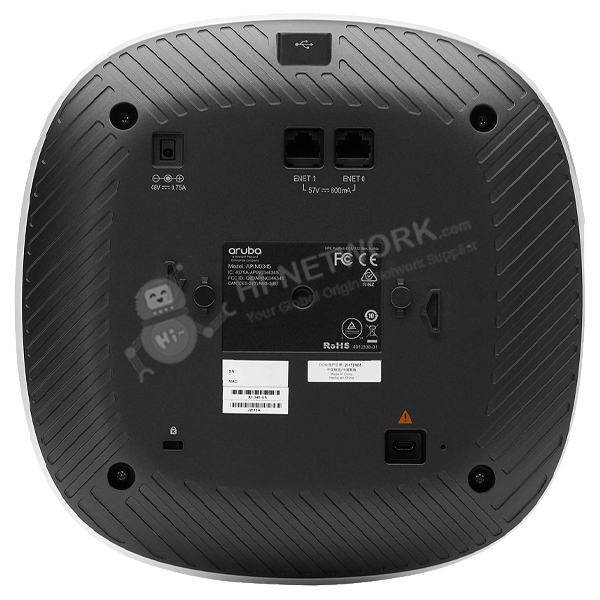





| Détail: | Aruba AP-345 (RW) Dual 4x4:4 MU-MIMO Radio Internal Antennas Smart Rate Unified Campus AP |
| Modèle: | Aruba AP-345 (RW) (JZ031A) |
| État: | Usine scellée nouveau |
| En relation: | |
| Garantie: |
 3 Years-Warranty
3 Years-Warranty
 100% satisfait ou remboursé
100% satisfait ou remboursé
 Service après-vente gratuit
Service après-vente gratuit
|
| Livraison: |
Transport aérien à
États-Unis d’amérique
,La plupart des clients reçoivent pendant 5-7 jours
?
Si vous finissez le paiement aujourd’hui,
Votre commande arrivera dans le Délai de livraison estimé. |
| Expédié à:
3.24
|
2 à 7 jours
US$
|
| Paiement: |
Plus de détails
|
JZ031A is the Aruba AP-345 (RW) Dual 4x4:4 MU-MIMO Radio Internal antennes Smart Rate Unified Campus AP....... The Aruba 340 series access points provide the fastest 802.11ac gigabit data speeds and superb user experience for mobile devices and applications in a digital workplace. Designed with an integrated, 802.3bz Compliant, HPE SmartRate multi-gig Ethernet port to eliminate wired bottlenecks, these APs offer unmatched wireless performance and capacity. The unique and flexible dual-5 GHz architecture of the 340 series offers a way to double 5 GHz capacity where needed, without compromise or restrictions.
modèle | JZ031A |
Les séries | Aruba AP-345 |
AP type | Indoor, dual radio, 5 GHz 802.11ac 4x4 MIMO and 2.4 GHz 802.11n 4x4 MIMO |
Description Description Description | Aruba AP-345 (RW) Dual 4x4:4 MU-MIMO Radio Internal Antennas Smart Rate Unified Campus AP |
Dimension (excluding mount accessories) | 225mm (W) x 224mm (D) x 52mm (H) |
Poids poids | 1.05kg |
OperatingTemperature | 0° ° c ° c ° c ° cC à +50°C (+32°F to +122°F) |
Température de stockage | -40 -40°C à +70°C (-40°F to +158°F) |
humidité | 5% to 93% non-condensing |
Maximum number of BSSIDs | 16 BSSIDs per radio |
Supported frequency bands (country-specific restrictions apply) | ● 2.400 to 2.4835 GHz ● 5.150 to 5.250 GHz ● 5.250 to 5.350 GHz ● 5.470 to 5.725 GHz ● 5.725 to 5.850 GHz |
Antenna | 4 Internal Omni-directional 5.6dBi Antenna |
Maximum No. of associated client devices | Up to 256 associated client devices per radio |
Supported data rates (Mbps) | ● 802.11b: 1, 2, 5.5, 11 ● 802.11a/g: 6, 9, 12, 18, 24, 36, 48, 54 ● 802.11n: 6.5 to 600 (MCS0 to MCS31) ● 802.11ac: 6.5 to 1,733 (MCS0 to MCS9, NSS = 1 to 4 for VHT20/40/80, NSS = 1 to 2 for VHT160) ● 802.11ac: 1,950 and 2,166 (MCS10 and MCS11, NSS = 1 to 4 for VHT20/40/80, NSS = 1 to 2 for VHT160) |


- The 340 Series APs can be deployed in either controllerbased (ArubaOS) or controllerless (InstantOS) deployment mode
- Supports up to 2,166 Mbps per radio in the 5 GHz band (with 4SS/VHT80 or 2SS/VHT160 clients) and up to 800 Mbps in the 2.4 GHz band (with 4SS/VHT40 clients)
- Antenna polarization diversity (fixed) for optimized RF performance
- Both 5 GHz radios providing full coverage, doubling the performance and capacity
- Unlike competitive solutions, the 340 Series is designed to isolate the two 5 GHz transmitters for higher performance
- Conversion can be manual/fixed, or automatic and dynamic (software controlled, under-the hood), based on system-wide capacity and load in both bands
- Supports up to 2.5 Gbps with NBase-T and IEEE 802.3bz Ethernet compatibility
- Backwards compatible with 100/1000Base-T
- Enables location-based services with BLE-enabled mobile devices receiving signals from multiple Aruba Beacons at the same time
- Enables asset tracking when used with Aruba Asset Tags
- Minimizes interference from 3G/4G cellular networks, distributed antenna systems and commercial small cell/femtocell equipment.
- Supports priority handling and policy enforcement for unified communication apps, including Skype for Business with encrypted videoconferencing, voice, chat and desktop sharing.
- Integrated AirMatch technology manages the 2.4-GHz and 5-GHz radio bands and actively optimizes the RF environment including channel width, channel selection and transmit power.
- Adaptive Radio Management (ARM) technology provides airtime fairness and ensures that APs stay clear of all sources of RF interference to deliver reliable, high performance WLANs
- Capable of part-time or dedicated air monitoring, the spectrum analyzer remotely scans the 2.4 GHz and 5 GHz radio bands to identify sources of RF interference from HT20 through VHT160 operation.
- Device assurance: Use of Trusted Platform Module (TPM) for secure storage of credentials and keys as well as secure boot.
- Integrated wireless intrusion protection2 offers threat protection and mitigation, and eliminates the need for separate RF sensors and security appliances.
- IP reputation and security services identify, classify, and block malicious files, URLs and IPs, providing comprehensive protection against advanced online threats.
- SecureJack-capable for secure tunneling of wired Ethernet traffic.
- Enables the AP to continuously monitor and report its actual power consumption and optionally make autonomous decisions to disable certain capabilities based on the amount of power available to the unit.
- Software configurable to disable capabilities in certain orders. For the 340 Series Access Points, by default, the USB interface will be the first feature to turn off if the AP power consumption exceeds the available power budget.
modèle | JZ031A | JZ033A |
Description | Aruba AP-345 (RW) Dual 4x4:4 MU-MIMO Radio Internal Antennas Smart Rate Unified Campus AP | Aruba AP-345 (US) Dual 4x4:4 MU-MIMO Radio Internal Antennas Smart Rate Unified Campus AP |
LAN sans fil Standard | IEEE 802.11ac | IEEE 802.11ac |
Bande de fréquence | 5 GHz 2,40 GHz | 5 GHz 2,40 GHz |
Antennas | 8 Internal Antennas | 8 Internal Antennas |
Vitesse de Transmission sans fil | 3 Gbit/s | 2.50 Gbit/s |
Facteur de forme | Montable au mur Plafond montable | Montable au mur Plafond montable |
Do you have any questions about the JZ031A?
Contactez-nous maintenant via [email protected].
Fiche technique spécifique:
JZ031A Specification | |
Les séries | Aruba AP-345 |
AP type | Indoor, dual radio, 5 GHz 802.11ac 4x4 MIMO and 2.4 GHz 802.11n 4x4 MIMO |
Description Description | Aruba AP-345 (RW) Dual 4x4:4 MU-MIMO Radio Internal antennes Smart Rate Unified Campus AP |
Dimension (excluding mount accessories) | 225mm (W) x 224mm (D) x 52mm (H) |
Poids poids | 1.05kg |
OperatingTemperature | 0° ° c ° c ° c ° cC à +50°C (+32°F to +122°F) |
Température de stockage | -40 -40°C à +70°C (-40°F to +158°F) |
humidité | 5% to 93% non-condensing |
5GHz radio | ● Four spatial stream Single User (SU) MIMO for up to 1,733 Mbps wireless data rate to individual 4SS VHT80 or 2SS VHT160 client devices ● Four spatial stream Multi User (MU) MIMO for up to 1,733 Mbps wireless data rate to up to four 1SS or two 2SS MU-MIMO capable client devices simultaneously ● Peak datarate increases to 2,166 Mbps when using 1024-QAM modulation (proprietary extension) |
2.4GHz radio | ● Four spatial stream Single User (SU) MIMO for up to 600 Mbps wireless data rate to individual 4SS HT40 client devices, and up to 800 Mbps to individual 4SS VHT40 devices (proprietary extension) |
Maximum number of BSSIDs | 16 BSSIDs per radio |
Supported frequency bands (country-specific restrictions apply) | ● 2.400 to 2.4835 GHz ● 5.150 to 5.250 GHz ● 5.250 to 5.350 GHz ● 5.470 to 5.725 GHz ● 5.725 to 5.850 GHz |
Available channels | Dependent on configured regulatory domain. |
Supported radio technologies | ● 802.11b: Direct-sequence spread-spectrum (DSSS) ● 802.11a/g/n/ac: Orthogonal frequency-division multiplexing (OFDM) |
Supported modulation types | ●802.11b: BPSK, QPSK, CCK ● 802.11a/g/n/ac: BPSK, QPSK, 16-QAM, 64-QAM, 256-QAM, 1024-QAM (proprietary extension) |
Antenna | 4 Internal Omni-directional 5.6dBi Antenna |
Maximum No. of associated client devices | Up to 256 associated client devices per radio |
Supported data rates (Mbps) | ● 802.11b: 1, 2, 5.5, 11 ● 802.11a/g: 6, 9, 12, 18, 24, 36, 48, 54 ● 802.11n: 6.5 to 600 (MCS0 to MCS31) ● 802.11ac: 6.5 to 1,733 (MCS0 to MCS9, NSS = 1 to 4 for VHT20/40/80, NSS = 1 to 2 for VHT160) ● 802.11ac: 1,950 and 2,166 (MCS10 and MCS11, NSS = 1 to 4 for VHT20/40/80, NSS = 1 to 2 for VHT160) |
802.11n high-throughput (HT) support | HT 20/40 |
802.11ac very high throughput (VHT) support | VHT 20/40/80/160 |
802.11n/ac/ax packet aggregation | A-MPDU, A-MSDU |
Transmit power | Configurable in increments of 0.5 dBm |
Maximum (aggregate, conducted total) transmit power (limited by local regulatory requirements) | ● 2.4 GHz band: +24 dBm (18dBm per chain)5 ● 5 GHz band: +24 dBm (18 dBm per chain)5 ● Note: Conducted transmit power levels exclude antenna gain. For total (EIRP) transmit power, add antenna gain. |
Certifications Certifications | ●CB Scheme Safety, cTUVus ● UL2043 plenum rating ● Wi-Fi Alliance certified 802.11a/b/g/n, ac ● WPA, WPA2 and WPA3 – Enterprise with CNSA option, Personal (SAE), Enhanced Open (OWE) ● Wi-Fi CERTIFIED™ ac (with wave 2 features) ● Passpoint® (Release 2) with ArubaOS and Instant 8.3+ |
Ce qui est garanti.
Après avoir reçu votre commande, prenez un mois complet pour l’essayer. Si vous trouvez que la qualité n’est pas bonne, nous#39; vous le reprendrez et vous rembourserez votre argent. Votre entière satisfaction est garantie ou votre argent remis. Que et#39; S garanti.
Après vos articles de commande qui sont disponibles. Nous utiliserons la plupart de manière rapide de la livraison aux pays globaux. Normalement nous embarquerons des cargaisons pendant 3 -5 jours. Et la livraison internationale prendra environ 3- 10 jours selon votre emplacement.
Le Service ne s’arrête jamais.
Matériel Warrany temps:
Nouveau matériel Original scellé: 3 ans
Appareils originaux remis à neuf/usagés: 1 an
Après le temps de garantie, vous pouvez également nous contacter pour retourner de nouveau pour le service de réparation. Tout ce que vous achetez sur HI-NETWORK.COM. Nous offrirons l’appui en ligne de vie de service pour vos n’importe quelles questions possibles.

DELL utilisé R740 Rack Server

Best 10Gb Switch for SMB in 2025: Unlock Next-Gen Network Performance
Huawei 12700E-4, as a wireless controller, now requires wireless Mac address authentication for Internet access

S5735-L48T4S-A: Complete Guide with Features, Specifications, and Benefits

S5735-L48P4X-A1: Reliable PoE+ CloudEngine Switch

S5735-L48LP4XE-A-V2: Scalable, Secure, and PoE-Ready for Demanding Enterprise Deployments

S5735-L48LP4S-A-V2 Powers Smarter Campus Networks with Advanced PoE and Cloud Management

S5735-L24T4X-A1 Empowers Installers with Scalable, Reliable, and Efficient Network Access

Best Ethernet Switches for Business (2025): Selection Guide and Top Picks
Is there a command on Huawei switches that lists the interface speeds?